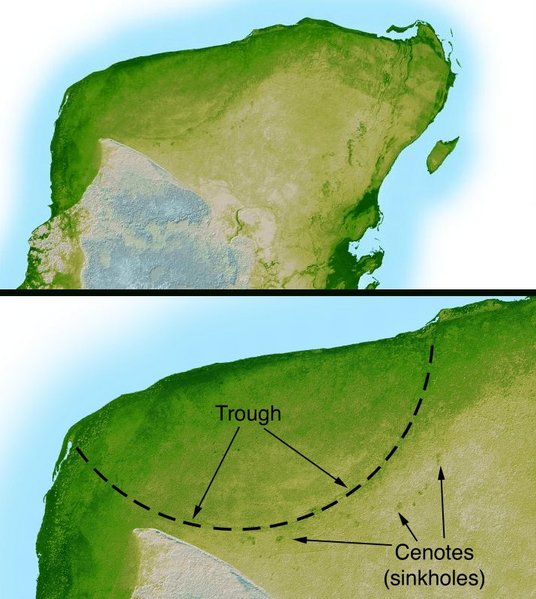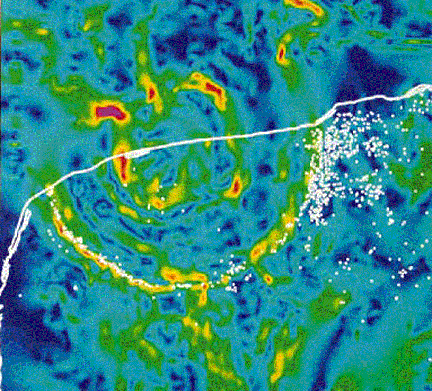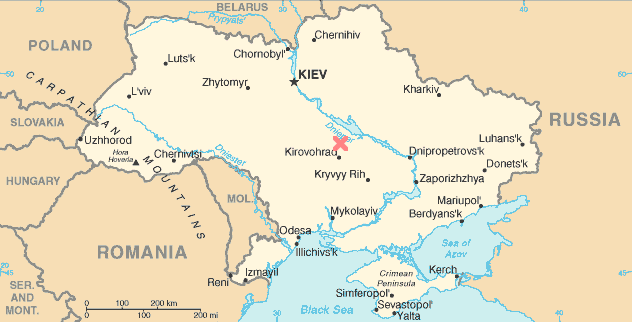Deeper Impact: Did Mega-Meteors Rattle Our Planet?
On the west coast of India, near the city of Mumbai, lies a tortured landscape. Faults score the ground, earthquakes are rife, and boiling water oozes up from below forming countless hot springs.
These are testaments to a traumatic history. Further inland, stark mountains of volcanic basalt provide compelling evidence that this entire region - an area of some 500,000 square kilometres known as the Deccan traps - underwent bouts of volcanic activity between 68 and 64 million years ago.
We don't know why. The Deccan traps lie far away from any tectonic plate boundaries, those fractures in Earth's crust through which lava usually forces its way up from the planet's interior. No volcanism on the scale implied by the Deccan traps occurs on Earth now. However, smaller, equally mysterious "hotspots" dot the globe away from plate boundaries - the smoking volcanoes of the Hawaiian islands, for example, or the bubbling geysers of Yellowstone National Park in Wyoming.
Geologists have generally thought that the history of such features can be traced through the slow churnings and contortions of rock under pressure in Earth's mantle. But it seems there is more to it than that. Sometimes volcanic activity needs - and gets - a helping hand from above.
It was in the late 1960s that oil companies prospecting off India's western coast found something odd in the rocks beneath the ocean floor. Sediments laid down on an ocean bed over millions of years generally form rocks resembling a layer cake, with the layers getting older the deeper you delve. That was true in the boreholes drilled off the coast near Mumbai, to a point. But some 7 kilometres down, in a layer of rock deposited 65 million years ago, the neat progression abruptly stopped. Beneath it was a layer of shattered rock, followed by a layer of solidified volcanic lava up to 1 kilometre thick.
Something equally dramatic lurked onshore in the layered lava flows of the Deccan traps. These flows are interrupted by intermediate layers of sedimentary rocks, indicating that the volcanic activity that shook and remodelled the area from about 68 million years ago was not continuous. It was also not catastrophic; fossils found in the sedimentary layers suggest that dinosaurs had coexisted with this activity reasonably well.
But rooted in layers of lava dating from 65 million years ago - around the time dinosaurs disappeared from Earth's fossil record - are colossal spires of lava of a fundamentally different composition. These spires are up to 12 kilometres high and 25 kilometres across at their base, so that their tips appear as surface hills. The lava they are made of is highly alkaline and rich in iridium, an element rare in the Earth's crust but which commonly occurs in meteorites.
The lava in the Deccan traps is rich in iridium, an element rare in the Earth's crust but which commonly occurs in meteorites.
To palaeontologist Sankar Chatterjee of Texas Tech University in Lubbock, all of this was telling a story. In 1992, he recounted it to the world: the entire basin area off the coast of Mumbai, he claimed, was a huge undersea impact crater, some 500 kilometres across, formed when a meteorite 40 kilometres in diameter slammed into Earth 65 million years ago and convulsed its surface. He named the crater Shiva, after the Hindu god of destruction and renewal, and touted it as the big brother of Chicxulub, a crater 180 kilometres across under the Yucatán peninsula in Mexico, which dates to the same time.
This claim was bound to stir controversy. The aftermath of the Chicxulub impact supposedly did for the dinosaurs and many other species that disappeared in a wave of extinctions around that time. If Chatterjee was right, Chicxulub was unlikely to be the whole story.
Most geologists were unconvinced. For a start, the Shiva crater was simply too large. Whereas massive impacts were common in the rambunctious early days of the inner solar system, the absence of recent large craters on Mercury, Venus and Mars strongly suggests that those days are long gone. "These surfaces demonstrate that objects larger than 30 kilometres have not produced impacts in the last three billion years," says planetary geologist Peter Schultz of Brown University in Providence, Rhode Island.
Chatterjee responds that there are still objects of the right size out there, for example the near-Earth object 1036 Ganymed that NASA is monitoring closely, although it is happily not on a collision course with Earth. Moreover, he says that studies off the Indian coast by oil companies in the 1990s revealed gravitational anomalies that add weight to his arguments.
The exact strength of the gravitational pull an object feels at the Earth's surface differs from place to place. It is weaker in areas dominated by low-density granite rocks, for example, and stronger where high-density basalt rocks dominate. If you cross from one side of the posited Shiva crater to the other, the gravity signal weakens towards the centre before reversing and becoming much stronger again towards the proposed rim.
That, says Chatterjee, squares with the idea that a meteorite hit what is now the Mumbai coast from the south-east at an oblique angle of 15 degrees to the horizontal, obliterating the crust entirely and scraping away a portion of the upper mantle, too. The impact would have thrown up a granite peak 50 kilometres high that collapsed back down through a pool of rock below that had been melted in the impact.
That would explain not only the anomalous area of lower gravity under the ocean, but also the odd geology of the Deccan traps. As the granite peak collapsed it too melted, causing the impact crater to overflow and creating enormous melt ponds of alkaline, iridium-rich lava in the charred surroundings. Meanwhile, the shock of the impact caused the moderate Deccan volcanic eruptions, already occurring nearby, to go into overdrive. "A lava trickle became a torrent," says Chatterjee. This torrent of normal lava enclosed the iridium-rich lava overflow from the impact, producing the stunning enclosed spire architecture seen in the Deccan layers today.
That is at best half an answer: it does not explain where the Deccan volcanic activity came from in the first place. Many palaeoscientists, including Chatterjee, think this was linked to a hotspot currently active under the island of Réunion in the Indian Ocean. This hotspot may well have been beneath the area of the Deccan traps 68 million years ago, before continental drift moved them apart.
Even so, it is a contentious claim: to suggest that impacts can amplify volcanic activity is to give them a far greater influence on Earth's recent geological history than has conventionally been allowed. The effects might not just be volcanic, either. According to Chatterjee's calculations, the force of the impact could have been enough to open up a new rift in Earth's crust to the west of the crater, causing a tiny sliver of western India to migrate out into the sea as new oceanic crust forced its way up. The most obvious sign of such a detached sliver today lies almost 2800 kilometres south of the Indian mainland - the island group of the Seychelles.
Comparison with other impact sites shows that if the Shiva crater exists and if it is as big as proposed, the impact would indeed have released enough energy to have such effects. "The physics of the process is undeniable," says geophysicist Adrian Jones of University College London. Even if the Shiva impact never happened, in a startling twist it seems an impact could well have caused the massive Deccan eruptions.
To understand how that might be requires an abrupt change of scene, to the icy permafrost of northern Siberia. This region contains a huge expanse of volcanic rock just as curious as the Deccan traps - and, at some 2 million square kilometres, roughly four times the size. These Siberian traps contain slabs of lava up to 3 kilometres thick that were formed in a single event 251 million years ago.
For geochemist Asish Basu at the University of Rochester in New York, this was fascinating, not least because the lava's date tallies with the largest mass extinction known, the Permian-Triassic extinction, in which over half the existing animal families died out.
Where did so much lava come from over such a short period? When Basu analysed the chemical composition of the rock to find out, it threw up a surprise. The lava showed abnormally high concentrations of the isotope helium-3, generally a signature of rocks from far down in Earth's interior. "Something was causing the deep mantle to come up, but we did not know what," says Basu.
A hole punched by an impact, perhaps? Basu was aware of Chatterjee's work, and it was tempting to float a connection between two huge unexplained lava flows, each dating from the same time as a mass extinction. So Basu travelled to India to do his helium analysis on the rocks there, too. He came up with the same anomalous result.
For Basu, that only deepened the mystery. For one thing, there was no noticeable impact site anywhere near the Siberian lava flows. For another, he was not convinced that the Shiva site was actually an impact crater.
His brainwave was that it didn't matter. "A big impact anywhere would have shaken the planet and created pressure that might have amplified deep-mantle volcanic activity already in progress," he says. If that was so, whether Shiva was an impact crater or not was irrelevant. An impact anywhere in the world could have been the trigger for the Deccan volcanism; arguably, it could even have been the well-documented Yucatán impact.
Shaken and stirred
Basic physics says that is plausible. "The idea of volcanic activity being primed and increased by energy waves sent through the mantle by impacts elsewhere on the planet is a reasonable one," says Jones. Pressure waves from earthquakes travel extremely well through the inner layers of the Earth: seismographs in Europe and the US routinely pick up tremors thousands of miles away in China, for instance. A superpowerful pressure wave such as one created by a huge impact could well have done enough to rattle volcanic plugs and stir lava domes, activating otherwise mild or dormant volcanism.
A superpowerful pressure wave created by a huge impact from space could rattle volcanic plugs and activate dormant volcanism.
To lend credence to the idea, what Basu needed was evidence of a meteorite impact 251 million years ago - not in Siberia, but anywhere. That had him stumped until 2003, when he and his colleagues were handed a 251-million-year-old rock sample from near the Beardmore glacier in Antarctica. Within the rock, they found inclusions with an odd chemical composition that looked for all the world like meteorite fragments. They published a paper detailing the exciting discovery and its possible implication: that the two largest volcanic events in the past billion years could have been caused by meteor impacts (Science, vol 302, p 1388).
The claim caused a considerable stir, and many geologists dismissed the Antarctic finding out of hand. "A lot of criticism came because folks figured it wasn't possible for meteorite fragments to last so long," says Eric Tohver of the University of Western Australia in Perth. Meteorites are mostly metal and would usually be expected to rust away into nothingness over 100 million years, even if buried. The fragments must be modern, said the critics, and somehow have infiltrated the sediments.
Undeterred, Basu and his colleagues pressed on with their exploration. In March this year, at a conference of planetary scientists in Houston, Texas, they presented what they consider to be a smoking gun: more meteorite fragments, this time enclosed in clay containing fossils that date them to 251 million years ago. Clay readily absorbs water, drawing off moisture and preventing meteorite fragments from rusting away.
Scepticism remains. "Small meteorites fall from the sky all the time," says Schultz. "Just because these meteorite fragments are the same age as the Siberian lava does not mean they and the Siberian lava flows are related."
As debated as Chatterjee's and Basu's ideas are, the concept that extraterrestrial bodies might have direct geological effects is now more widely accepted. "The idea of impacts causing volcanism is absolutely plausible," says Vicki Hansen, a planetary geologist at the University of Minnesota, Duluth: modelling shows that impacts can readily melt a planet's surface layer where it is relatively thin.
The question is what sorts of volcanic activity that might generate. Might impacts help to explain the hotspots of Hawaii and Yellowstone, for example? Hansen is open-minded, but sceptical. "There can be little doubt that an impact could spawn a type of hotspot given the right conditions," she says. The crust beneath Hawaii, though, seems relatively intact, and the hotspot looks to be the result of a bulge of superheated mantle, or "plume", forcing its way up for reasons unknown. We know less of what underlies Yellowstone; there is no evidence yet that an impact played a significant part there.
With other hotspots it is a different story. The Ontong Java plateau lies beneath the western Pacific, north of the Solomon Islands, and it is a hotspot that was active some 125 million years ago. The upper layers of the mantle are uplifted there, but not as much as under Hawaii. A likely explanation is that an impact fractured the crust, allowing melt from below to rise and spill out as an eruption. The escape of so much melt material would reduce the density of what was left behind, causing the mantle bulge seen today (Earth and Planetary Science Letters, vol 218, p 123).
How long such impact-induced fireworks might have lasted is another area of debate. Tohver thinks not so long - a few hundred thousand years, perhaps a few million. "It is a lot like dropping a spoon into thick pea soup," he says: the initial large disturbance would quickly die down. Schultz agrees, on the basis of studies of other solar system bodies. "Theoretical models concluded that impacts could not trigger sustained eruptions," he says.
Jones begs to differ, arguing that better modelling will show that sustained eruptions can result from impacts. "A major difference between the Earth and our neighbouring planets is that Earth is still very hot and geologically active, so may be much easier to melt with impacts," he says.
The debate will rage on, but one thing seems certain: accumulating evidence means the days of thinking about geology without considering influences from above are numbered. "Geologists don't typically consider impact hypotheses, perhaps for psychological reasons," says Hansen. "We have been trained to consider things that come from within our planet." Being forced to consider the effects of random meteorite strikes adds another complexity to an already involved subject. But in the end, says Hansen, "We are never going to get anywhere if we keep trying to understand our planet with our hands over our eyes and ears."










 NASA’s Lucy mission blasted into outer solar system to study Trojan asteroids & planetary evolution (VIDEO)
NASA’s Lucy mission blasted into outer solar system to study Trojan asteroids & planetary evolution (VIDEO)